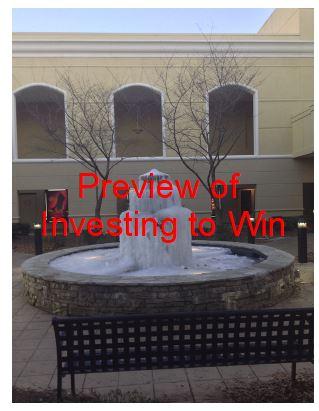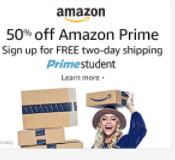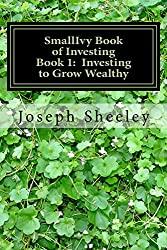
I’m very excited to say that the writing on my newest book, Investing to Win, is done! Out in the ether of the internet there is a 215 page Google Doc with the manuscript (and a copy saved on my computer, just in case). I’m now in the process of editing, which always seems to take a lot longer than you would expect. This means that, hopefully, the book will be ready to buy by Christmas time or early in 2022.
(Note, this site contains affiliate links. As an Amazon Associate I earn from qualifying purchases. When you click on an affiliate link and buy something, The Small Investor will get a small commission for the referral. You are charged nothing extra for the purchase. This helps keep The Small Investor going and free. I don’t recommend any products I do not fully support. If you would like to help but don’t see anything you need, feel free to visit Amazon through this link and buy whatever you wish. The Small Investor will get a small commission when you do, again at no cost to you.)

This is my third book. My first book, The SmallIvy Book of Investing, Book 1: Investing to Grow Wealthy, covered all of the basic about investing, including what stocks, bonds, REITs, options, warrants, and other types of investments are. More importantly, it covered the risks involved. It also described what you should be doing at each stage of your life to grow wealthy by investing. This book is seeing a bit of a resurgence after it (finally!) got a review on Amazon by someone who liked it and gave it fiver stars. Thank you to Barton Nixon for the review. I’m glad you liked the book!

Want all the details on using Investing to grow financially Independent? Try The SmallIvy Book of Investing
The second book, FIREd by Fifty: How to Create the Cash Flow You Need to Retire Early, provides a game plan for how you should be handling your money to get the most out of every dollar you make. It also covers investing, but the main feature is the creation of a cashflow plan where you set up your finances in such a way that you create a wealth-building feedback loop. This is how you get the money you need to invest. Done correctly, you could reach financial independence within about 25 to 30 years even if you don’t have a rock star income. It also makes sure that you’re saving the money you’ll need for the things that will come up in life that many people don’t prepare for (like the air-conditioner gong kapoot). By staying out-of-debt, you get the most for your hard-earned money.

(If you enjoy The Small Investor and want to support the cause, or you just want to learn how to become financially independent, please consider picking up a copy of my new book, FIREd by Fifty: How to Create the Cash Flow You Need to Retire Early This is the instruction manual on how to become financially independent.)
The reason for this third book is that I really didn’t have a book on stock picking and I’ve had a lot of people ask for one. Investing to Grow Wealthy covers how to invest, including investing in individual stocks, but people were really needing to understand how to choose stocks. That’s where Investing to Win comes in. (Note, it may become The SmallIvy Book of Investing, Book 2: Investing to Win, just to complete the series. I’m not sure yet.)

Investing to win actually goes beyond stock picking. It describes the investment style that I’ve developed after years of trying different things. Spoiler alert: It’s buy-and-hold investing, but that’s what I’ve found actually works. But it isn’t just buying and holding anything. It’s finding the right kinds of stocks to buy, and then holding them until they’re no longer the right kind of companies to be holding. I also spend a lot of time on mutual fund investing for those who don’t want to do stock picking and because you’ll need to use mutual funds in your 401k fund anyway.
As I’ve said, I’m in the process of editing, so the book won’t be out for a while. I also wanted to spend sometime promoting the book and getting some pre-sale excitement going. (There are a lot of games that need to be played with Amazon, such as getting a lot of presales out there so that the book gets listed high enough up on Amazon that people might actually see it.) Look for presales starting in a few months with the release maybe around the start of next year. Expect a nice discount on the presale.
To whet your appetite, I’ve included the foreword for the book below. Hopefully there are a few people out there as excited as I am for its release.
Foreward
This investing methodology presented in this book is the result of lessons learned after a long journey involving some wins, some losses, and a lot of wasted time. Over the 35+ years that I have been investing, I have tried numerous strategies with varying degrees of success. Early on, in my preteen and teenage years, I bought small quantities of shares in different companies. The very first company I purchased, Tucson Electric Power, shot up to the moon, going from $15 per share to over $80 per share before falling back to earth by the time I reached college. Other companies, like Stop and Shop, never really went anywhere. I also bought individual bonds, seeing some do well and others disappear as the company issuing the bonds went bankrupt.
During college I read a book or two about options, where you can make huge amounts of money in a few weeks or lose everything you put in within a month or two. I chose a specified amount of money to put at risk and decided to give it a shot with both index and equity options. I would watch CNBC during the day when I didn’t have class, trying to figure out when to buy and sell. I remember one time falling asleep and waking up an hour or two later having made a thousand dollars. But while when I started I had set aside an amount I had planned to risk, I actually ended up losing about five times as much before all was said and done! When you lose money but learn something, it’s called “paying tuition to the markets.” I paid a lot in tuition that summer. I learned not to play with options.

Need to catch up on your reading but don’t have time? Are you a big fan of listening to books and podcasts? Try Audible Plus
It isn’t that I lost money during all of those early years while I was learning, but I didn’t make as much money as I could have. For example, some years I may have made 5% when I could have made 10%. Sometimes I may have sold a stock, feeling good with a $1000 profit when I could have made $5000 or $10,000. Many years my broker ended up making more in commissions than I made in profits. If a money manager had been trading for me and generating all those fees for himself, it would have been called “churning,” which is considered a disreputable practice. As it was, I was hurting myself.

But over time, I learned what works and what doesn’t, changing and honing my strategy. I also did a lot of reading. Books like Burton Malkiel’s A Random Walk Down Wall Street taught me that watching CNBC was useless when it came to improving investment returns. Do You Want to Make Money, or Would You Rather Just Fool Around by J.D. Spooner taught me that I wasn’t making anywhere close to as much as I should have been making on my individual stock trades. For fun I read books like Rogue Trader: How I Brought Down Baring’s Bank and Shook the Financial World which details Nick Leeson’s attempts to trade his way out of a hole created by an associate in the world of arbitrage (where is supposed to be a no risk way to basically print money) which resulted in him destroying one of the world’s oldest banks in a few months. (You can watch the 1999 film Rogue Trader for a fictionalized account of the story if you aren’t into reading.)
If you can start from my ending point, you can avoid all of the wandering I did and start right out with what really works. And the best news is that the best strategies are fairly easy, not taking a huge amount of knowledge or a lot of time to implement. If you can learn from my experience and not make my mistakes, you can press fast forward on your financial path and start from the place it took me 25 years to reach. Since returns grow exponentially, not linearly, this will mean the difference in returns of millions, not thousands, of dollars over your lifetime.

But I won’t ask you to simply accept the methods I prescribe. You need to know not just what to do, but why it works, so we’ll start with a discussion of what investing is and how it works. Once you understand this, it will be obvious why the strategies prescribed are the best path to maximize your returns.
Have a burning investing question you’d like answered? Please send to [email protected] or leave in a comment.
Disclaimer: This blog is not meant to give financial planning or tax advice. It gives general information on investment strategy, picking stocks, and generally managing money to build wealth. It is not a solicitation to buy or sell stocks or any security. Financial planning advice should be sought from a certified financial planner, which the author is not. Tax advice should be sought from a CPA. All investments involve risk and the reader as urged to consider risks carefully and seek the advice of experts if needed before investing.
